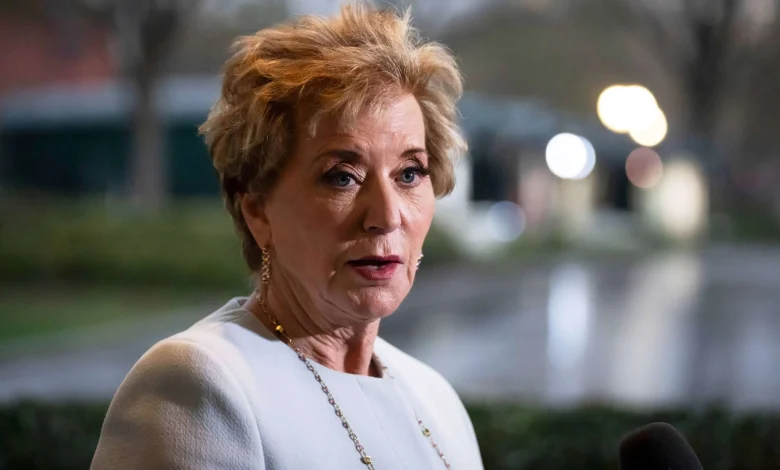Education Dept soft-launches employee reassignments to other agencies, in latest step of closure plans

The Education Department, in the latest step of the Trump administration’s plan to dismantle the agency, has begun transferring its employees to other federal agencies.
The department said Tuesday that it signed six new interagency agreements to transfer some of its programs and employees to the departments of Labor, Interior, State and Health and Human Services, in order “to break up the federal education bureaucracy.”
Education Secretary Linda McMahon told employees in an all-hands meeting that the department is soft-launching plans to reassign its work to other parts of the federal government, before calling on Congress to permanently shutter the agency.
McMahon, in a transcript obtained by Federal News Network, told employees that Education is currently transferring its employees out to other agencies “on a temporary basis.”
]]>
That temporary reorganization, she said, will give the Education Department a proof-of-concept to show lawmakers. At that point, the Trump administration will call on Congress to pass legislation that will officially shut down the department and codify the reorganization.
The department, she added, has already transferred 13 employees to the Labor Department, “so that we can be more efficient and economical,” and that more interagency agreements will soon be signed to transfer other staff.
McMahon said the Education Department’s budget still covers those 13 detailed employees, and that the Education and Labor Departments are currently “co-managing” them.
McMahon told employees that she has spoken to members of Congress about this reorganization plan, and is planning to move programs out of the Education Department “on a temporary basis” for now. But in the end, she said the Trump administration’s goal is to find enough votes in Congress “to close the Department of Education.”
“If it has worked, and we have proven that this is the best way to do it, then we’ll ask Congress to codify this and make it a permanent move out of the Department of Education into whatever agency that program has gone into,” McMahon told employees.
President Donald Trump signed an executive order in March, calling for the dismantling of the Education Department. McMahon told lawmakers during her confirmation hearing that the Education Department is set up by Congress, and “it clearly cannot be shut down without it.”
The department, so far this year, has lost about half of its employees through mass layoffs and voluntary separation incentives.
]]>
McMahon didn’t mention immediate layoffs or workforce reductions as part of this phase of the reorganization plans, but acknowledged shutdown-era layoffs could return in early 2026.
McMahon said the Education Department has cancelled reduction-in-force notices it sent to about 20% of its remaining workforce during the 43-day government shutdown.
The continuing resolution passed by Congress and signed by Trump put those RIF notices on hold at least through Jan. 30, 2026.
But beyond that point, McMahon acknowledged that RIFs may return.
“Moving forward, that creates unrest. It creates uncertainty for all of you, and I understand that,” she told employees. “I know how difficult it is to make decisions that, from my perspective, are going to affect people’s lives and their livelihood and their teams and what they’re working on. And it is not an easy decision.”
McMahon said a majority of the public didn’t support plans to close the Education Department, when the Trump administration first announced its plans. However, she said the majority of the public does support shifting these programs to other agencies to make them more efficient.
“When the goal will be to have congressional votes to close the Department of Education, we are not closing education. We’re lifting education up, and each of us in this room has a chance to be part of history, and that this is part of our legacy,” she said.
The six interagency agreements will move billions of dollars in grant programs to other agencies. The Labor Department, in particular, will oversee much of the federal funding that will go to K-12 schools, including grants for schools serving low-income communities.
The department says states and schools shouldn’t expect any disruptions to their funding, except that federal funds will now come from the Labor Department.
]]>
“The funding will not change. That may flow through a different account or a different building,” McMahon told employees.
The reorganization would move two of the Education Department’s largest programs, the Office of Elementary and Secondary Education and Office of Postsecondary Education, to the Labor Department.
However, the Education Department will still retain student loan oversight and accreditation of colleges to ensure they are eligible to receive students’ federal financial aid.
Critics of the reorganization say that the agencies taking on Education programs and personnel don’t have expertise in these policy areas, and that the transfer could disrupt some of its essential programs.
“That national mission is weakened when its core functions are scattered across other federal or state agencies that are not equipped or positioned to provide the same support and services as ED staff,” AFGE Local 252 President Rachel Gittleman said.
The Associated Press contributed to this story
If you would like to contact this reporter about recent changes in the federal government, please email jheckman@federalnewsnetwork.com, or reach out on Signal at jheckman.29
Copyright
© 2025 Federal News Network. All rights reserved. This website is not intended for users located within the European Economic Area.





